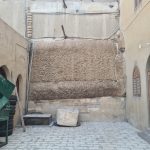DAYR AL-ḤAMMĀM
| Arabic | دير الحمّام |
| English | Dayr el-Hammam | Deir el-Hammam | Deir Abu Ishaq |
| DEChriM ID | 26 |
| Trismegistos GeoID | 2756 |
| Pleiades ID | - | PAThs ID | 336 |
| Ancient name | - |
| Modern name | Dayr al-Ḥammām |
| Latitude | 29.243846 |
| Longitude | 30.996836 |
| Date from | - |
| Date to | - |
| Typology | Monastic settlement |
| Dating criteria | - |
| Description | "The monastery known as Dayr al-Ḥammām or Dayr Abū Isḥāq or Monastery of the Virgin is located in the south area of the Fayyūm, about 7 km north of the Middle Kingdom pyramid of al-Lāhūn. The first two names of the monastery are mentioned together, for the first time, in the “Book of the Hidden Pearls” (Daressy 1917, 198). The “modern” monastery – that is the result of several restorations and adaptations of the original structure – is built on top of a little hill. It is clear that the small structure that stands today represents only a little part of the original monastic complex, as is demonstrated by the enormous quantity of pottery sherds scattered on the surface of the kom and the remains of mud brick walls emerging from the sand... Within the surrounding wall of the modern monastery, the church dedicated to the Virgin Mary is located inre-uses several materials of the ancient church, in particular in the northeastern area and the khurus. A big capital has been reused, upside down, as a base of a column. In 1889 the collaborators of F. Petrie found in the area several literary and documentary manuscripts that are now preserved in the British Library. Petrie wrote to W.E. Crum: “The Deir has been rebuilt a few centuries ago, but there are outlines of a much larger Deir showing on the ground. Outside the older Deir are rubbish-mounds. Here we found plenty of scraps of papyrus” which the natives ”brought and sold to me in scrap lots. I never had any occasion to suspect any outside admixture. Most of the Hammam pieces had evidently just been dug up; certainly they had never passed through a dealer’s hand. The Hawara papyri were all found, scrap by scrap, by my own workmen. There were no circumstances to suggest in the least that these were found elsewhere or imported” (Crum 1893, v). The monastery is mentioned by Abū Ṣāliḥ al-Armāni, but not by al-Maqrīzī, a fact that suggests that in the fifteenth century was abandoned for some centuries, until the modern revival." - Paola Buzi and Agostino Soldati |
| Archaeological research | The first ‘archaeological’ work was the exhumation of numerous Coptic manuscripts in 1889. It is impossible to know from exactly where these manuscripts came, however, due to the lack of documentation. Additionally, the surface area of the monastery was cleaned in the mid-2000s, revealing pillars and capitals likely of the original monastery (Buzi 2005: 279-296). |
• Buzi, P. 2005. “Tra ascetismo e cenobitismo: Gli insediamenti monastici fayyumici.” Aegyptus 85: 279–296.
• Buzi, P. 2012. “Il settore cristiano.” In Bakchias. Dall’archeologia alla storia, edited by E. Giorgi and P. Buzi, 179–211. Bologna: Bononia University Press.
• Crum, W. E. 1893. Coptic Manuscripts Brought from the Fayyum by W.M. Flinders Petrie, Esq. D.C.L. Together with a Papyrus in the Bodleian Library. London: David Nutt.
• Kamal, A. B. 1902. “Rapport sur la nécropole d’Arabe-el-Borg.” Annales du Service des antiquités de l’Égypte 3: 80-84
• Timm, S. ed. 1984-1992. Das Christliche-Koptische Ägypten in Arabischer Zeit: Eine Sammlung Christicher Stätten in Ägypten in Arabischer Zeit unter Ausschyss von Alexandria, Kairo, des Apa-Mena-Klosters (Der Abu Mina), der Sketis (Wadi n-Natrun) und der Sinai-Region, vol. 2, 587-588. Weisbaden: Dr Ludwig Reichert.


 Json data
Json data








